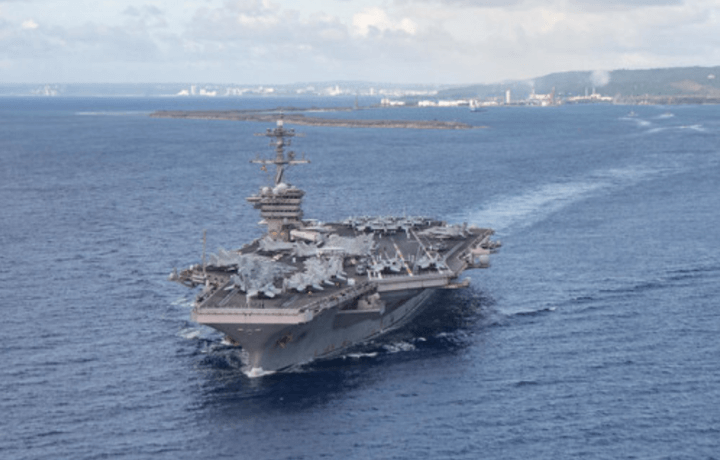The USS Theodore Roosevelt (CVN-71), the fourth Nimitz-class nuclear powered aircraft carrier in the United States Navy, finally returned to sea late last month after being sidelined in Guam since late March due to the spread of COVID-19 among the crew. As of April 12, 585 crew members had tested positive for the novel coronavirus, and one day later, one of the sailors died.
Of the total 4,800 sailors and marines serving on board the carrier, 1,273 had contracted the coronavirus.
Navy and CDC Study
Last week, a new six-week study of 382 sailors conducted by the Navy and the Centers for Disease Control and Prevention (CDC) found that about 62% (236 individuals) had been infected with the SAR-CoV-2, which is the coronavirus that causes COVID-19. Of those sailors who had contracted the virus, nearly one in five, or 18.5%, were asymptomatic.
Among those who were symptomatic, the loss of smell and taste were the most common symptoms; and service members with COVID-19 were 10 times more likely to report the loss of taste and smell compared to those not infected. Other commonly-reported symptoms included muscle pain and chills.
Mirroring the outbreak in the general public, the infection was more common among males than females, but did not differ significantly by age, race, ethnicity or history of a preexisting medical condition.
Those sailors who took preventive measures had a lower infection rate compared to those who did not – 55.8% vs. 80.8% for face masks; 53.8% vs. 67.5% for avoiding common areas; and 54.7% vs. 70% for social distancing.
The study also found that about 60% of sailors on the Theodore Roosevelt had developed antibodies for the virus, which meant that their respective immune systems had developed some form of protection. However, the CDC has cautioned that it is unclear if having antibodies does in fact protect one from re-infection, or even how long possible immunity may last.
“This is a stealthy virus and the results from this outbreak investigation provides us with increased knowledge about COVID-19 so we can better protect the crew, their shipmates on other vessels, and ultimately the nation,” said Rear Adm. Bruce Gillingham, U.S. Navy Surgeon General, via a statement.
The study’s findings were in line with previous outbreaks on cruise ships, which also reported undetected transmission of COVID-19 due to mild and/or asymptomatic infections. As with other respiratory viruses, COVID-19 appears to spread more easily between people in close quarters, which is why those serving on U.S. Navy vessels have been seen to be at high risk.
“This study paints a picture of current and prior SARS-CoV-2 infection among young adults living in close quarters,” said study CDC author Dan Payne, PhD. “This data will contribute to understanding COVID-19 in the U.S. military, as well as among young adults in other close communal environments.”
U.S. Navy’s Response
CVN-71 may have been the most high-profile U.S. warship to be impacted by the pandemic, but it was not the only U.S. Navy vessel to be taken out of service in recent months due to an outbreak amongst the crew.
In late April, the Navy reported that there were cases of coronavirus on 26 warships, and as a precautionary move, those ships returned to port or maintenance yards. However, the Navy also announced that there were as many as 90 ships at sea that had no reported cases, which is why the decision was made to keep the USS Harry S. Truman Carrier Strike Group (HSTCSG) at sea off the East Coast of the United States.
The carrier has completed its most recent deployment, but the ship remained at sea to keep the crew healthy during the COVID-19 pandemic and to remain combat-ready to take on missions as needed. It was an unusual move, as the strike group had conducted two deployments in a row without any major maintenance period, but HSTCSG was the only on-call strike group on the East Coast at the time.
In preparation for the latest deployment of the Navy’s newest carrier, the USS Gerald R. Ford (CVN-78), the crew had been quarantined to help reduce the spread of the coronavirus among its crew. This has continued as the carrier undergoes tests of its systems and brings its Carrier Air Wings on board.
Impact on Navy Around the World
While the crew of the USS Theodore Roosevelt was recovering from the outbreak, the French Navy’s only aircraft carrier, Charles de Gaulle , was forced to return to its home port of Toulon after 50 sailors of it 1,760 crew tested positive.
As the ship headed back to port, extra measures were aimed at protecting the crew to contain the spread the virus, such as requiring all sailors to wear face masks.
Great Britain’s Royal Navy has also taken precautionary efforts. They have quarantined pilots who were set to deploy on the new aircraft carrier Queen Elizabeth. Only pilots who had tested negative for the coronavirus were allowed to land their jets on board.
In April, the Royal Navy had announced that every one of the 600 sailors and airmen who would serve on the carrier would have to be tested for the disease, and then placed in quarantine. Two of the crew members did test positive and were removed from the ship.
Even as the U.S. Navy and its allies deal with threats around the world, it seems the greatest one right now might be the unseen virus. While cruise ships have the luxury of remaining in port, the Navy still needs to find a way to safely function.




